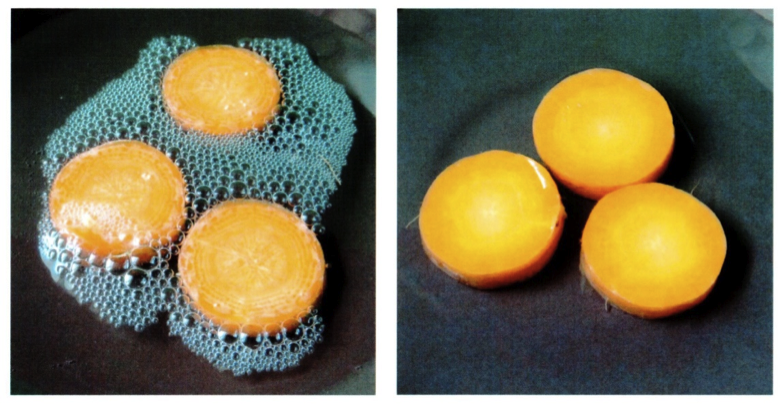Don Mercer
In a previous article, we discussed the importance of blanching certain fruits and vegetables prior to freezing or drying them.
One of the benefits of blanching is that it acts as a treatment to destroy microorganisms on the surface of the product. It’s like a pasteurization process for your fruits and vegetables, if you care to think of it that way.
Another reason for blanching is to deactivate naturally occurring enzymes that are found in the tissues of much of the produce we eat. Enzymes are really protein molecules that have what we call “bio-activity” – they are biologically active. They speed up specific reactions which otherwise would proceed very slowly, or perhaps not at all. While these enzymes are not harmful to the consumer, they can cause deterioration of food quality with time. A good example of this is the discolouration of cauliflower which turns brown, purple, or black due to the presence of an enzyme called polyphenol oxidase.
By plunging the cauliflower florets into boiling water and holding them there for several minutes, the polyphenol oxidase enzyme loses its bio-activity and can no longer promote the reaction that leads to these undesirable colours.
What I would like to do now is prove to you that blanching does work and re-emphasize the critical role it plays in maintaining quality when processing fruits and vegetables that are prone to these enzymatic reactions. To do this, we will consider sliced carrots that we intend to freeze.
Carrots and many other garden crops produce minute quantities of hydrogen peroxide as a by-product of their metabolism while they are growing. If the concentration of the hydrogen peroxide was allowed to increase unchecked, it could become problematic to the plant. In order to prevent the build-up of hydrogen peroxide, these plants produce a peroxidase enzyme to convert the peroxide to water and oxygen, which are harmless.
In this simple experiment, which you can do at home in your kitchen, all we need is a carrot; a bottle of hydrogen peroxide (3%), which you can buy at the pharmacy or dollar store; and a few basic kitchen utensils.
To prove that the peroxidase enzyme is present in the tissue of the carrot, cut three or four thin slices from your raw carrot and place them in a shallow bowl or saucer. Being careful not to spill any of the hydrogen peroxide solution, gently pour some over the raw carrot slices. After a short time, you should see tiny bubbles clustering around the sides of the carrot slices. These are oxygen bubbles that have been generated by the reaction of the peroxidase enzyme with the hydrogen peroxide solution. Since you did not add any enzyme to the carrots, it had to have been present naturally. You have basically flooded the carrots with hydrogen peroxide, but that doesn’t matter. The enzymes kick into gear and start doing their job to rid the system of the peroxide.
For blanching, take three or four thin slices of raw carrot and put them in a heat-resistant container like a coffee mug (don’t use your best china for this!). Pour some boiling water directly from the kettle into the mug to half fill it. Using a fork, stir the carrot slices to improve their contact the hot water and prevent them from sticking together. You need to blanch the carrot slices for about three minutes. Bring the kettle back to boiling, and after a minute or so into the blanching process, pour the water out of the mug. Use the fork to prevent the carrot slices from escaping. Then, quickly refill the mug with the fresh boiling water. In this way, the temperature of the water will not drop too much.
After blanching the carrot slices for three minutes, pour off the hot water and cool the carrot slices under cold running water. This will stop the blanching process.
Now you can test your blanched carrots to see if the peroxidase enzyme is still active. Place the slices of blanched carrots in a shallow bowl or saucer. Carefully pour some peroxide over these slices and look to see if there are any bubbles. If you have done the blanching properly, there will be no bubbles. This indicates that you have successfully deactivated the peroxidase enzyme.
Hopefully, this little experiment will prove to you that blanching is an effective method of deactivating enzymes. Since it worked with the peroxidase enzymes in the carrots, it will work with other enzymes as well, such as those responsible for the discolouration of cauliflower.

Tiny oxygen bubbles have accumulated around the raw carrots in the peroxide solution (left photo), but do not appear around the blanched carrots in the peroxide solution (right photo).
Dr Don Mercer is Associate Professor in Food Science, Department of Food Science, University of Guelph, Guelph, Ontario N1G 2W1, Canada; e-mail: dmercer@uoguelph.ca
Permission to reproduce this article is greatly appreciated and acknowledged.
IUFoST Scientific Information Bulletin (SIB)
FOOD FRAUD PREVENTION